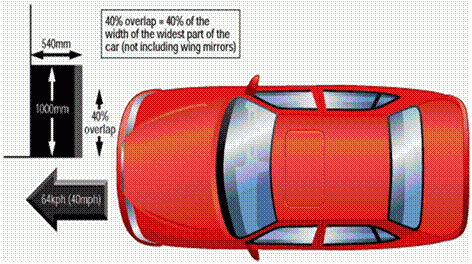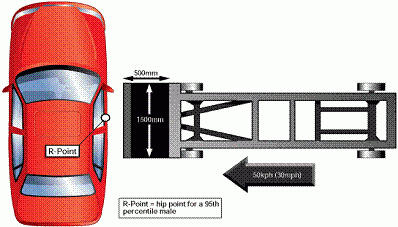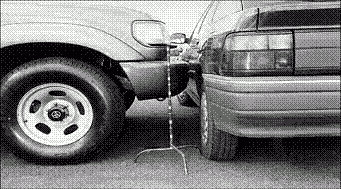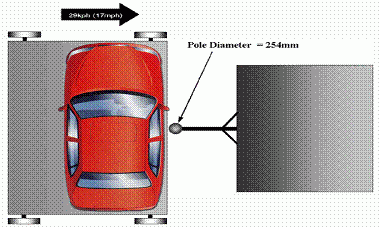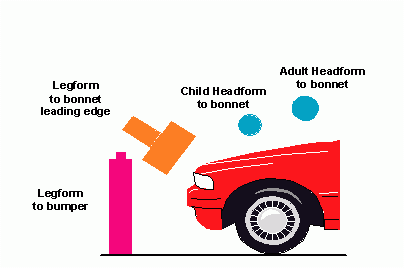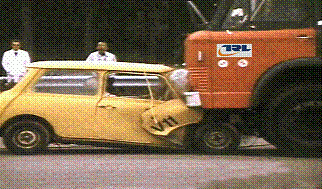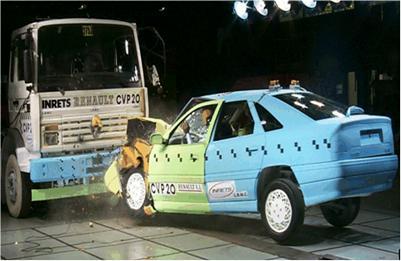- Bicycles
- Buses and coaches
- Heavy goods vehicles
- Light vans and minibuses
- Motorcycles
- Safety design needs
Cars
Crash avoidance measures
While crash avoidance is the logical first objective for vehicle engineering for safety, vehicle crash avoidance measures are, in general, in their infancy in terms of development and practical application. In several cases, they hold much future promise. In other cases, technological solutions either address relatively minor road safety problems, are of unknown effectiveness or the technological application has still to be proven practicable. The focus of this section is on the former, although some coverage is given to measures in the latter category which may be of current interest.
Speed
Intelligent Speed Adaptation (ISA)
ISA is a system which informs, warns and discourages the driver to exceed the speed limit. The in-vehicle speed limit is set automatically as a function of the speed limits indicated on the road. GPS allied to digital speed limit maps allows ISA technology to continuously update the vehicle speed limit to the road speed limit. There are three types of ISA:
Informative or advisory ISA gives the driver a feedback through a visual or audio signal
Supportive or warning ISA increases the upward pressure on the gas pedal. It is possible to override the supportive system by pressing the accelerator harder.
Intervening or mandatory ISA prevents any speeding, for example, by reducing fuel injection or by requiring a "kick-down" by the driver if he or she wishes to exceed the limit.
The more the system intervenes, the more significant are the benefits. Estimates by the Institute for Transport Studies at the University of Leeds show that if mandatory installation of informative or supportive ISA, injury crashes could be reduced by 20%. The use of a mandatory ISA system, when combined with a dynamic speed limit regime, has the estimated potential to reduce overall injury crashes by up to 36%, fatal and serious crashes by 48% and fatal crashes by 59%. A study in the Netherlands showed that ISA could reduce the number of hospital admissions by 15% and the number of deaths by 21%.
Different trials using informative and supportive systems across Europe have shown that approximately 60-75% of users would accept ISA in their own cars. A FIA Foundation survey indicates 61% support for physical in-car limiter systems to prevent exceeding speed limits in residential areas, and over 50% support for these systems on main roads and motorways.
The Swedish Road Administration (SRA) plans to equip its whole fleet with ISA systems and experimental studies are underway or have been carried out in Norway, the Netherlands and the UK. There have been two major European-funded projects on ISA. The SRA co-ordinated project PROSPER looked into ways that advanced assisted driving technology and technology relating to speed limitation devices can improve safety, and what are the barriers for the implementation of ISA. SpeedAlert co-ordinated by ERTICO harmonises the in-vehicle speed alert concept definition and investigates the first priority issues to be addressed at the European level, such as the collection, maintenance and certification of speed.
Black boxes
Black boxes or event recorders can be used in cars as a valuable research tool to monitor or validate new safety technology, to establish human tolerance limits and to record impact speeds. Current general practice is to use the onboard computer which now is fitted on most cars, and to adapt the transducers and the data collected. In the US, the car manufacturer GM has been using event data recorders since the 1970s to evaluate the performance of airbags in crashes. In the UK, police fleet cars have been fitted with black boxes. In Germany a special crash recorder called UDS by Mannesmann/VDO has been on the market for more than 15 years. Experience in Germany gained with this recorder shows that it can influence driving behaviour considerably and thus contributes to crash reduction, especially in vehicle fleets, of between 20 - 30%. In Sweden, approximately 60,000 vehicles have been equipped with event recorders for research purposes since 1995.
An EC project VERONICA is collating information to assist the European Commission on the feasibility of black boxes in European vehicles. Three important questions related to black box are the standardisation of procedure and tool to retrieve the data, the use of the data collected (for crash research, or by the police to check driving conditions, or in legal applications to help in the determination of the responsibilities in a crash) and questions concerning the ownership of the data.
Visibility
Daytime Running Lights (DRL)
(DRL) are multi-purpose or specially designed lights on the front of a vehicle for use in daytime to increase its visibility and avoid multi-party crashes. At present nine European countries have compulsory DRL for cars and the European Commission is considering proposals for an EU-wide requirement. There are various options for DRL introduction, all of which have positive benefit to cost ratios. The options of mandatory manual operation of dipped lights in existing cars and a compulsory advanced DRL unit fitted to new cars seem most advantageous, according to a Dutch review.
Meta-analyses of the effects of DRL use in cars show that DRL contributes substantially to reducing road crashes, car occupant and vulnerable road user injuries whatever the country's latitude. A reduction in multi-party crashes of between 8%-15% was found as a result of introducing mandatory laws on daytime use. A Norwegian meta-analysis of 25 studies that have evaluated DRL for cars and 16 studies that have evaluated DRL for motorcycles found that DRL reduces the number of multi-party daytime crashes by 5-10 per cent. A Dutch review found that DRL reduced multi-party daytime crashes by around 12% and deaths and injured victims by 25% and 20% respectively. Motorized two-wheeler users have expressed concerns that daytime running lights on cars could reduce the visibility of motorcyclists. While there is no empirical evidence to indicate this is the case, such an effect is likely to be offset by the benefits to motorcyclists of increased car visibility. For further information, see SWOV Fact sheet.
Does car colour influence road safety?
Brightly coloured or light coloured vehicles are sometimes regarded as safer because they seem to be more visible but is this the case? While a small number of studies have started to explore this question the association between the colour of cars and their safety should be treated with some caution. For instance, if yellow cars were proven to be safer than other colours, it does not mean that safety would improve if all cars were yellow. It is the variation in colour, just as much as the colour itself that generates differences in safety.
Braking and handling measures
Anti-lock Braking Systems (ABS)
The main purpose of ABS is to prevent skidding where loss of steering and control result from locked wheels when braking hard. Such systems are now fitted to many new cars. A meta-analysis of research studies shows that ABS give a relatively small, but statistically significant reduction in the number of crashes, when all levels of severity and types of crashes are taken together. However, while injury crashes decrease (-5%), fatal crashes increase (+6%). There are statistically significant increases in rollover, single-vehicle crashes and collisions with fixed objects. There are statistically significant decreases in collisions with pedestrians/cyclists/animals and collisions involving turning vehicles. ABS brakes do not appear to have any effect on rear-end collisions.
A German study found that ABS brakes can lead to changes in behaviour in the form of higher speeds and more aggressive driving. The results also may also be partly due to lack of knowledge or incorrect assumptions amongst car drivers about how ABS brakes actually function. A British study, for example, indicated that one reason why ABS was not realising its full potential to reduce crashes was that many drivers had little or no knowledge of ABS.
Brake Assist
Brake Assist in emergency situations is a technology which comes as standard on some new cars and is being proposed by the car industry as part of an EU legislative package on pedestrian protection. It aims to address the problem of insufficient pressure being applied to the brake by drivers in emergency situations, so increasing stopping distances. Car manufacturing trials have shown that brake assistance systems could help by providing full braking effect, where the driver does not press hard enough on the pedal. In marketing material, Daimler Chrysler indicate that for a car braking at 100km/h, BrakeAssist can reduce the normal stopping distance by 45%. Brake assistance systems can use the ABS capability to allow heavy braking without the risk of wheel locking, but have to distinguish between emergency and normal braking as well as respond appropriately to reduced brake pressure.
While various prospective estimates have been made, the casualty reduction effect of Brake Assist has yet to be scientifically established. In general most of the devices described for improvement of braking and handling interfere with driver behaviour, and the questions of driver acceptance, risk compensation and driver reaction when the system is activated (especially old drivers) are important. Unlike for passive safety there is no standard method to assess the safety performances of these devices, which makes it difficult to estimate their potential benefits; moreover, under the same name very different systems can be found, as each manufacturer has its own specification.
Electronic Stability Control (ESC)
Electronic stability control (ESC) addresses the problem of skidding and crashes due to loss of control on wet or icy roads. Such devices are now being introduced onto the luxury large car market and are recommended by the European New Car Assessment Programme EuroNCAP ESP.
Evaluation studies have shown that ESC can lead to substantial reductions in crashes involving large, luxury cars. A Swedish study in 2003 showed that cars fitted with ESC were 22% less likely to be involved in crashes than those without with 32% and 38% fewer crashes in wet and snowy conditions respectively. In Japan, a study showed that electronic stability reduced crash involvement by 30-35%. In Germany, one study indicated a similar reduction while another showed a reduction in "loss-of-control" crashes from 21% to 12%. Whether or not the same benefits from ESC will be derived from smaller cars will need to be studied.
Impairment detection systems
Several systems exist for detecting driver impairment caused by excess alcohol, drowsiness, illness, or drug abuse, which prevent the vehicle from starting or warn the driver or perform an emergency control function that will stop the vehicle. While many systems are at different stages of development with, in some cases, their feasibility being unknown, one particularly promising application is the alcohol interlock system.
Alcohol interlock systems are automatic control systems which are designed to prevent driving with excess alcohol by requiring the driver to blow into an in-car breathalyser before starting the ignition. The alcohol interlock can be set at different levels. These have been used widely in North America in repeat drink-drive offender programmes and, when used as part of a comprehensive scheme, have led to reductions of between 40%and 95%in the rate of repeated offending. See ICADTS Working Group Report 1. Alcohol interlock systems are also widely used in Sweden in rehabilitation schemes for offenders driving with blood alcohol content over the legal limit and in government and company fleet cars. In 2004 the Swedish government decided that all vehicles purchased or leased in 2005 or later, and intended to be used by the government should be fitted with alcohol interlocks. More than 5000 company cars in Sweden are today equipped with alcohol interlocks and the number is rapidly growing. A transport company in Sweden decided to equip all their 4000 vehicles with alcohol interlock systems before the end of 2006. The Swedish Driving Schools Association has fitted all their 800 vehicles with alcohol inter-locks.
Collision Avoidance Systems
Research on collision warning and collision avoidance systems is taking place in Japan, the United States and in the European Union within the European Commission's an Esafety programme. Very large estimates of the safety potential of such systems have been claimed following laboratory studies, but the range of technical and behavioural issues involved in many of the concepts require full on-road assessment. To be practicable, most of the proposed systems require a well controlled traffic situation, such as that found on motorways, but where the casualty reduction potential is relatively low. Various systems are under development:
- Forward Collision Warning
- Reverse Collision Warning System
- Adaptive Cruise Control
- Lane-Keeping Devices
Implementing intelligent transport systems for road safety
Intelligent transport systems (ITS) require a detailed international framework for implementation which currently does not exist. Such a framework includes work on standardisation, the development of functional specifications for ITS measures and Memoranda of Understanding on their fitment and use. Digital maps, sensors, ensuring appropriate human machine interface, as well as developing communication protocols all form part of the implementation process. Establishing public acceptance as well as legal liability for ITS measures are also fundamental issues.
Crash protection measures
Fundamental issues of structures, compatibility and restraint
What happens in a typical crash?
Newton's Third Law, states that "For every action there is an equal and opposite reaction." In a frontal crash, the most common impact type, an unrestrained occupant continues to move forward at the pre-crash speed and hits the car structures with an impact speed approaching the pre-crash speed. Use of a seat belt or restraint helps to slow the occupant down in a crash by applying forces to the strong skeletal structures of the pelvis and rib cage; reducing the risk of major contact with the car structure and preventing ejection.
How does crash protection work?
Vehicle crash protection aims to keep the consequence of a crash to a minimum. For car occupants, this means:
- Keeping the occupant in the vehicle during the crash
- Ensuring that the passenger compartment does not collapse
reducing the crash forces upon the occupants by slowing down the occupant or pedestrian over as long a distance as possible and spreading the loads as broadly as possible to reduce the effect of the impact forces
- Controlling the deceleration of the car
So reducing the risk of:
- An unrestrained occupant being ejected from a car so increasing the risk of fatal injury;
- A poorly designed passenger compartment which reduces the occupant's survival space;
- Occupant contact with a poorly designed car interior or intruding object
The vehicle's structure, its compatibility with other vehicles or objects on the road and the design and use of the vehicle's restraint system are all key elements for crash protective design. The type of crash protection countermeasure used is dependent on the nature of the crash configuration, i.e. the direction of the impact (using clock direction) and the type of collision partner.
Structures
Crash protection needs to be provided for different parts of the car structure which are struck in different types of crashes. The most common injury-producing crash types are frontal crashes, followed by side impacts, rear impacts and rollovers. Legislative tests cover the crash performance of new cars in front and side impacts. Euro NCAP consumer tests provide a star rating for crash performance in front and side impact tests based on legislative tests, a pole test, sub-system pedestrian tests, and inspection of aspects of the vehicle interior and restraint systems.
Frontal impact
Figure 2
The current EU legislative test is a 40% offset deformable barrier test conducted at 56km/h. The current EuroNCAP test is conducted at 64km/h.
Various suggestions have been made for improvements in the legislative test EEVC.
For car occupants, contact with the car's interior, exacerbated by the presence of intrusion, is the greatest source of fatal and serious injury.
The recent priority in frontal impact protection has been to improve the car structure to endure severe offset impacts with little or no intrusion.
Without intrusion, the seat belts and airbags have the space to decelerate the occupant with minimum injury risk.
A full width frontal barrier test is used in other regions of the world to test occupant restraint systems. Both tests are needed to ensure crash
protection for car occupants (see World Report on Road Traffic Injury Prevention).
In side impacts the struck side occupant is directly involved in the impact. Contact with the car interior is difficult to prevent so the aim is to improve the nature of the intrusion and provide padding and side airbags.
Side impact
Figure 3
Head protection is a priority in side impact which is not yet addressed in the current EU legislative test. In addition to a side impact test, EuroNCAP has a pole test which is encouraging improved crash protection for the head in side impacts.
Various suggestions have been made for improvements in the legislative side impact test EEVC
Rollover crashes
- Most rollovers occur off the carriageway. Providing the occupant is not ejected from the vehicle and the car does not strike any rigid objects, then rollovers are the least injurious of the different impact types;
- If occupants remain completely inside the car (i.e. no partial ejection) they have a low injury rate as they decelerate over a relatively long period;
Rear impacts
- Rear impact and whiplash type injury is a serious problem in terms of both injury and cost to society. Around 50% of neck injuries leading to disability following crashes occur in rear impacts.
- The risk of whiplash injury is not simply related to head restraint position, but is dependent on a combination of factors related to both head restraint and seatback design. Traditionally, attempts have been made to prevent injury by changes in the headrest geometry. A headrest located less than 10cm from the head has proved more beneficial than a distance of more than 10cm. Research into the injury mechanisms of neck injury have shown that the dynamic behaviour of seat backs is one of the parameters most influencing neck injury risks.
- Several special test dummies and test devices have been developed to date for the assessment of whiplash injury and several static and dynamic test procedures have been developed but not mandated.
Systems aimed at preventing neck injuries in rear impacts have been presented in recent years and used in several car models. Evaluation in real crashes has shown that an anti-whiplash system can reduce average whiplash injury risk by 50%; that energy absorption in the seat back reduced occupant acceleration and the risk of sustaining a whiplash injury; and further reductions in injury risk could be achieved by improved head restraint geometry. A Norwegian meta-analysis indicated that the effects of WHIPS systems differ with respect to injury severity. Slight injuries are reduced by about 20%, serious injuries by about 50%.
Compatibility
The varying mass of different cars and the different crash types make achieving compatible protection in car crashes quite complex. While cars mostly hit other cars either on the front or sides, they also hit roadside objects, pedestrians and commercial vehicles.
Compatibility is seen by vehicle safety experts as next major step forward in improving car occupant safety EEVC.
Car to car compatibility
Figure 4
Many new cars can absorb their own kinetic energy in their frontal structures in crashes, so avoiding significant passenger compartment intrusion. But when cars of different stiffness hit each other, the stiffer car overloads and crushes the weaker car.
When a car impacts with another, the stiff structures need to interact to minimise injury. There is currently no control of the relative stiffness of the fronts of different models of car.
For example, there's a need to reconcile sports utility vehicles with smaller passenger cars, which form the majority of vehicles on Europe's roads.
The question of geometry and matching of structures is also important to provide better compatibility, and avoid override/underride of different vehiclesand objects. The EEVC is developing test procedures to improve car-to-car compatibility for both front-to-front and front-to-side crashes and an EU-funded research programme VC Compat is co-ordinating international research.
Car to roadside objects
Figure 5
Impacts with roadside objects such as poles cause between 18%- 50% of car occupant deaths in EU countries.
Current legislation only requires the use of crash tests with barriers representing car-to-car impacts. A side car-to-pole test is practised in EuroNCAP Coordination is required between the design of cars and crash protective or 'forgiving' safety barriers.
Car to pedestrian
Figure 6
Most fatally injured pedestrians are hit by the fronts of cars. Four sub system tests have been devised by EEVC to test areas of the car front which are a source of serious and fatal pedestrian injury in impacts.
The tests at 40 km/h comprise:
- A bumper test to prevent serious knee and leg fractures;
- A bonnet leading-edge test to prevent femur and hip fractures in adults and head injuries in children;
- Two tests involving the bonnet top to prevent life-threatening head injuries.
Take up of these challenging tests could avoid 20% of deaths and serious injuries to vulnerable road users in EU countries annually European Commission, 2003. Recent minor amendments to the EEVC tests have been proposed following a EC funded feasibility study.
Bullbars: The European Commission has proposed action to prevent the installation of aggressive bull bars on car fronts.
Car to HGV
Figure 7
Front and rear under-run protection on trucks is a well-established means of preventing "under-running" by cars (whereby cars go underneath trucks with disastrous results for the occupants, because of a mismatch between the heights of car fronts and truck sides and fronts). Similarly, side protection on lorries prevents cyclists from being run over.
Legislative requirements for front rigid guards exist. Energy-absorbing front, rear and side under-run protection could reduce deaths in car to lorry impacts by about 12% (Knight, 2001). Research shows that the benefits of a mandatory specification would exceed the costs, even if the safety effect of these measures was as low as 5%.
Figure 8
Restraint
Occupant restraint is the single most important safety feature in the car and most crash protective design is based on the premise that a seat belt will be used.
Over the last 10 years restraint systems fitted in many new cars feature seat belts, frontal air bags, as well as seat belt pre-tensioning systems and belt force limiters which have done much to enhance seat belt protection. Measures to increase the use of restraints by means of legislation, information, enforcement and smart audible seat-belt reminders are central to improving the safety of car occupants. See World Report on Road Traffic Injury Prevention
Seat belts, seat belt reminders, smart restraint systems
Seat belts When used, seat-belts reduce the risk of serious and fatal injury by between 40%and 65% (For overview of studies see World Report on Road Traffic Injury Prevention). Typically, seat belts provide the best protection in frontal impacts, rollovers and in side impacts for the non struck side occupants. While front seat belt use is generally high in normal traffic in many parts of Europe, usage in fatal crashes has been shown to be as low as 30-50%. Seat belts, their anchorages and their use are covered by European legislation and standards. See European Commission.
Seat-belt reminders are intelligent, visual and audible devices that detect whether seat-belts are in use in various seating positions and give out increasingly urgent warning signals until the belts are used. EuroNCAP has developed a seat belt reminder specification and encourages their installation. Of all vehicles tested by EuroNCAP since 2003, 72% have seat-belt reminders. It is estimated in Sweden that reminders in all cars could contribute to a reduction of some 20% in car occupant deaths. They provide a cheap alternative to police enforcement with benefit to cost ratio of 6:1
Frontal airbags
Frontal airbags are fitted voluntarily by car manufacturers in most new European cars, although their use is required mandatorily in other regions such as the USA.
Effectiveness: Driver and front-seat passenger airbags reduce the risk of fatal injury by 68% when combined with seat-belt use. Airbags do not offer protection in all types of impact and do not reduce the risk of ejection. Airbags are no substitutes for seat belts, but are designed to work with them. Estimates of the general effectiveness of frontal air bags in reducing deaths in all types of crashes range from 8% to 14%.
Problems: Some of the protective measures provided by airbags that have been designed for adults in a normal seating position will pose a serious threat to children sitting rearward facing child seats and out-of-position (OOP) adults. Small drivers sitting close to the steering wheel are also at risk of being injured by the deploying airbag. The injury risk increases the closer the driver sits to the steering wheel and research shows that this reduces if the distance is 25 cms or over. Warning labels now have to be fitted in cars to avoid the installation of rearward facing child restraints and in some cars there is now provision for automatic detection of child restraints and out of position occupants or a manual switch to disconnect the passenger airbag system.
Head protecting airbags
Head protecting airbags are now increasingly common and help to provide protection for the head against impacts with the car's interior and particularly with structures outside the car. Their introduction, in combination with torso protecting airbags, offers the possibility of providing protection against the stiff B pillar (the stiff pillars in the middle of the passenger compartment). Monitoring of the effectiveness of head curtains in reducing injury is being carried out.
Side airbags
Research to date is inconclusive about the performance of side air bags in crashes which are designed to protect occupants in side impacts. No studies to date show convincing evidence of major injury reductions and there are some indications of airbag induced injuries.
Smart restraint systems
Smart restraint systems are vehicle restraint components or systems that adapt their geometry, performance or behaviour to suit varying impact types and/or occupants and occupant positions. None of the systems today adapts its characteristics to those of the person to be protected, and this is a key issue for the future with more biomechanical research needed. To date, most of the current smart restraint systems are intended to reduce the inflation power and aggressivity of frontal airbag systems. The future holds much promise for intelligent systems which can identify variables such as occupant physique and positioning, so providing more tailored crash protection. The objective of EC PRISM project is to facilitate the efficient and effective development of "smart restraint systems".
Child restraints
Children in cars need appropriate child restraints for their age and size. Several types of child restraint systems are in use within the EU. These include: infant carriers, child seats, booster seats and booster cushions. Infant carriers are used rearward-facing up to the age of 9 months. Both forward and rearward-facing child seats are used for children between 6 months and 3 years old. Booster seats and cushions are used forward facing up to approximately 10 years of age. All types are covered by European standards.
Effectiveness: The use of rearward facing restraints provides the best protection and should be used up to as high an age as possible (although not used adjacent to frontal passenger airbags). Rearward-facing systems have been shown to reduce injuries between 90% and 95%, while forward-facing systems have been shown to have an injury reducing effect of approximately 60%. The use of child safety seats has been shown to reduce infant deaths in cars by approximately 71% and deaths to small children by 54%.
Problems: Increasing the use of child restraint systems is the most important action in countries where the usage rate is low. Misuse of child restraints has in many EU Member States been identified as a major problem since most child restraints are not manufactured by car manufacturers and are not integrated into the original design of the car. Another problematic area for all child restraint systems is side impacts. EuroNCAP has shown the limited ability of current restraints to constrain the movement of the child's head and prevent contact with the car's interior. A side impact test procedure for child restraints is under the development within ISO TC22/SC12/WG1.
EuroNCAP has developed a child safety protection rating to encourage improve design. Points are awarded if universal child restraint anchorages ISOFIX are provided' for different types of child restraint provision and the quality of the warning labels or presence of de-activation systems for frontal passenger airbags.
Rear restraints
The rear seats of cars are occupied much less frequently that the front seats and the severity of injury is generally lower, where seat belts are worn. Occupants seated in the rear of cars are less exposed to intrusion problems so that improving the intrusion resistance of passenger compartments is likely to provide less benefit to rear seat occupants, particularly children. There are no legislative or crash tests which cover the crash protection of rear occupants or the performance of occupant restraints.
Head restraints
The risk of whiplash injury is related to both head restraint and seatback design and dynamic seat back tests. Evaluation in real crashes has shown that an effective anti-whiplash system can reduce average whiplash injury risk by 50%; that energy absorption in the seat back reduced occupant acceleration and the risk of sustaining a whiplash injury; and further reductions in injury risk could be achieved by improved head restraint geometry.
A headrest located less than 10cm from the head has proved more beneficial than a distance of more than 10cm. The greatest protection is provided by:
- Correct vertical adjustment. The top of the head rest must, if possible, be at the same height as the top of the head. The minimum is just above the ears.
- Correct horizontal distance between head and head rest. This must be as small as possible: in any case less than 10 cm and preferably less than 4 cm.
Head restraint ratings based on static measurements of head restraint geometry using the Head Restraint Measuring Device are used by the insurance industry around the world.
Car occupant interior head, knee and lower leg protection
Head injury
The head is the highest priority for protection. Although seat belts and frontal airbags offer protection, they do not prevent contact with the car's interior in all crash scenarios. For example, angled frontal impacts present considerable head injury risk as current restraint and airbag systems may not prevent contact with parts of the car such as the windscreen pillar. Interior surfaces that can be impacted by the head need to be padded and the idea of an interior headform test has been proposed as a potential tool by European vehicle safety experts. The EuroNCAP pole test, however, is encouraging increasing provision of head air bags in new cars.
Knee injury
Currently, there is no dummy instrumentation or biomechanical data in legislative tests to cover knee damage from direct impact against the knee. Furthermore, there is no test procedure for testing the whole of the potential knee impact area of the facia. Sources of knee injury are included in the EuroNCAP inspection procedure which forms part of the safety rating analysis.
Lower legs, feet and ankles
Lower leg injuries can result from direct impact against the fascia, parcel shelf or foot pedals or from loads applied to the foot or leg. Offset frontal collisions present a high risk for lower extremity injuries with long impairment and high societal costs. Crashworthiness optimisation to alleviate serious injury risk to some body regions leads to changes in injury distribution patterns and shifts the focus to other areas of the body. Injuries to the lower legs have been neglected until recently and the introduction of an improved dummy leg is awaited. Sources of injury to lower legs, feet and ankles are included in the EuroNCAP inspection procedure which forms part of the safety rating analysis.
Other issues - rescue systems
Emergency Notification Systems or 'Mayday' systems aim to reduce the time between when the crash occurs and when medical services are provided. By improving information transfer between the trauma care physician and emergency medical service personnel, they aim for faster and more appropriate treatment. In 2000, Autoliv and Volvo introduced one of the world's first post-crash safety systems.
Automatic Crash Notification (eCall) which is under development takes the safety benefits of Mayday systems further by providing emergency responders with data that indicates the severity of the crash and the nature of injuries sustained. A Finnish study has estimated that such a system might reduce between 4-8% of road deaths and 5-10% of motor vehicle occupant deaths in Finland.

